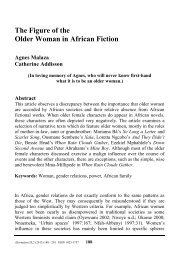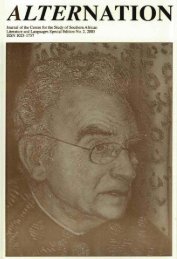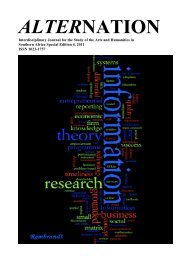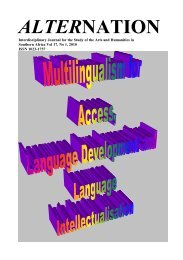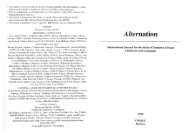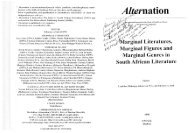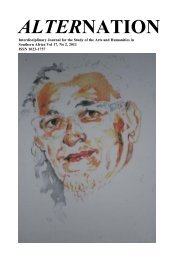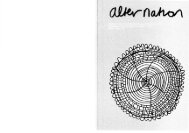Shane Moran - Alternation Journal
Shane Moran - Alternation Journal
Shane Moran - Alternation Journal
Create successful ePaper yourself
Turn your PDF publications into a flip-book with our unique Google optimized e-Paper software.
Ale\: la (I'11~zcr k Politics cr~z~i Aesthet<br />
lani Mkhize<br />
It was perhaps th~s attitude towards the Soviet Unron that prompted Lewis Nkos~,<br />
was with La Guma during the latter's first visit there m 1968, to allege:<br />
mporaries, but an accomplice in all the evil perpetrated in his country or by his<br />
e' (Solzhenitsyn 1972: 147).<br />
La Guma interrogates Solzhenitsyn's mystical or idealist conce~tion of the<br />
Alcv la Guma IS a man fie~cely and humourlessly comm~tted to 111s<br />
~deology-conimun~sm I was surpr~sed to d~scove~ how consc~vat~ve and<br />
uncr~t~cal lie was ~n 111s com~u~tnient Indeed there ale nrany ~ndependent<br />
Marvrst th~nkers who would bc ~rr~tated by 111s brand of p~o~~s rega~d ior<br />
cverythlng Sov~et pol~cy-makers are do~ng as almost beyond any<br />
qucstlonlng (Nkos~ 1975 110)<br />
ns of art. He points out that for ~olzhenitsin art is something that 1s 'above,<br />
ate from, people' and then argues, if it is true that 'we received [art] from Hands<br />
unable to see' (as Solzhenitsyn suggests), therefore 'we must conclude that<br />
ere was no humanity, no mankind, no people on earth, Art could st111 be there'<br />
uma 1974:70). Instead, La Guma offers a materialist explanation of the origins of<br />
, arguing that all art 'came from human endeavour'. 'Iftalent was not exercised. then<br />
To back up his argument Nkosi cites La Guma's 'implicit endorsement' of the tria<br />
two Soviet writers, Yuli Daniel and Andrei Sinyavsky, who had been prosecuted<br />
smuggling their manuscripts out of the countly. For Nkosi, on the co<br />
'strange' that, in his words, 'any artist interested in creative freedom, least of all<br />
Guma) ... who had himself been prosecuted and his works proscribed' (N<br />
1975: 11 0), would adopt such an attitude towards the fate of the other writers2'.<br />
Guma's critique of Solzhenitsyn six years later can therefore be seen in<br />
La Guma's general attitude to the critics of the Soviet Union in general and disside<br />
writers in particular.<br />
The most crucial part of La Guma's essay on Solzhenitsyn<br />
here is his critique of Solzhenitsyn's Nobel Lecture itself entitled, 'The<br />
in Society'. For it is precisely Solzhenitsyn's aesthetics, and his conception of the<br />
of a writer, which eventually become the main target of La Guma's critique. Bri<br />
summarised, for Solzhenitsyn art is of divine origin: 'there are no doubt<br />
foundations ... we received it fiom Hands we were unable to see',<br />
(Solzhenitsyn 1972: 142). Although Solzhenitsyn explains the source of art i<br />
(idealist) tenns he insists on the responsibility of a writer to his society. He is,<br />
quite emphatic on the freedom of the artist: 'Let us concede that the artist o<br />
to anyone' (Solzhenitsyn 1972:145). Implicit in his emphasis on the fre<br />
artist is his rejection of writers having to play a politically partisan role by espousin<br />
particular ideology. This is a clear demonstration of Solzhenitsyn's condemnation<br />
would-not have art', La Guma argues (La Guma 1974:70). Having said this, La<br />
terates his belief in the indivisible link between literature and life and employs<br />
to back up his argument: 'What the imagination creates is prompted by the facts<br />
life, and it is not governed by baseless fantasy, divorced from life, but very real<br />
' (La Guma 1974:7 1). On this basis, therefore, we may conclude that La Guma<br />
Gorky primarily because he shares with Gorky a materialist conception of the<br />
which the idea ofthe inseparability of literature and life stems.<br />
The assertion from Gorky (cited above) leads La Guma to the following<br />
f art: 'art is a representation of life' (La Guma 1974:71). If art is a<br />
on of life' as La Guma suggests, then, what is the role of the artist? For La<br />
sk of the 'real artist [is to search] for truth and to depict [that] truth' (La<br />
1974:75). This conception ofthe task of the writer has some affinity to Lukacs's<br />
in so far as it is suggestive of La Guma's heavy reliance on the honesty of the<br />
n his pursuit of 'truth'-and, as such, would seem to downplay the role of<br />
in this pursuit. For Lukacs (1 978:84), following Marx and Engels, the honesty<br />
writer, we know, means portraying 'reality as it actually is' even if, in the process;<br />
as to transcend one's 'most cherished preconceptions and most intimate personal<br />
]rations'. This is where La Guma parts company with LukAcs: for La Guma, the<br />
ch for truth is consistent with and perhaps too closely linked with the principle of<br />
isanship of literature as espoused by Lenin in 'Party Organisation and Party<br />
rature'. For this reason, LaGuma (1974:7 1) expands his definition of art:<br />
the officially sanctioned practice ofsocialist realism with its emphasis on t But, further, art is a representation of life also modified by the personality of<br />
of the l~eroic figures of the revolution. According to Solzhenitsyn, the writer has amoral<br />
rather than a political responsibility to his community and this is in line with the<br />
the artist; for the artist has a character, an outlook on life, the world around<br />
him, and through his art he hopes to modify the personality of others.<br />
mystical terms in which the origin of art is explained in Solzhenitsyn's aesthetics. In<br />
Solzhenitsyn's own words: 'The writer is not an outside judge of his compatriots and Once again, La Guma's indebtedness to Marxist aesthetics of realism can be seen not<br />
only in his definition of art as a reflection of social realitv but also in his<br />
achow~ed~ement of the role of ideology in this representation of reality. However, La<br />
'?<br />
Solzhenitsyn has since returned to R~~ssia and, in a dramatic turn of events. in an article<br />
which appeared in h.1oscow News (22 February 1987) it was reported that the trial of Sinyavsky<br />
and Daniel was 'now officially viewed as a mistake' (See Anon. 'Staggering Admission' in<br />
1nde-y on Censorship 5 1987: 1-5). 'Andrei Sinyavsky' is the pen-name of Abram Tertz who. like<br />
Solzhenitsyn. was critical of socialist realism and Stalinist repression. See his novel The Trial<br />
Begins and his accompanying critique entitled 'On Socialist Realism?.<br />
uma's use of the term, 'personality' instead of ideology -- could be seen as rendering<br />
lethe (at times) ad hocnature ofhis theory.<br />
La Guma's conceptualisation of the role of ideology in literature, one<br />
suspects, is attributable to his interpretation of Lenin's principle of partisanship as well<br />
as his so~newliatmechanistic version ofthe theoiy ofreflection. Earlier, in this essay, La<br />
ma e~nploys Gorky in reaffirming his belief in the Aristotelian dict~1111 that nian is a<br />
itical animal. Later, in the same essay, La Guma reiterates his conception of the



